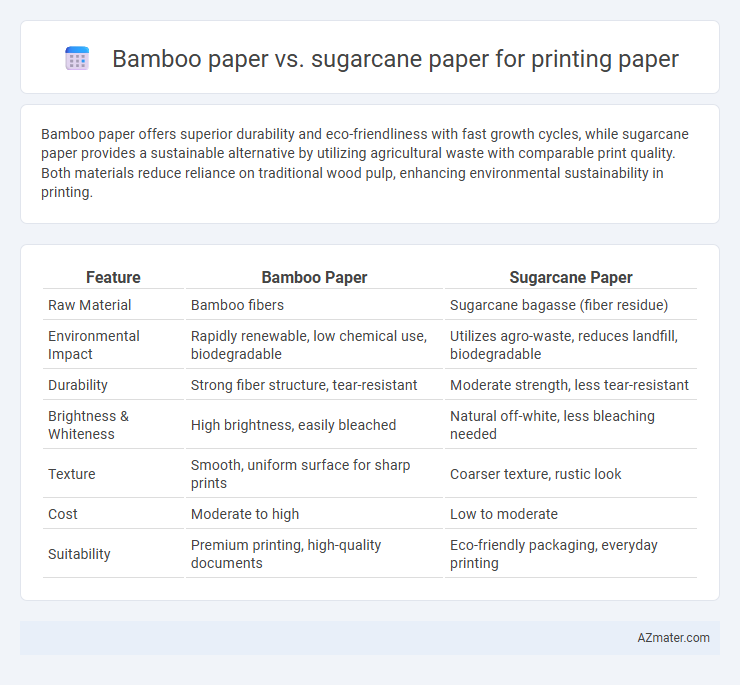Bamboo paper offers superior durability and eco-friendliness with fast growth cycles, while sugarcane paper provides a sustainable alternative by utilizing agricultural waste with comparable print quality. Both materials reduce reliance on traditional wood pulp, enhancing environmental sustainability in printing.
Table of Comparison
| Feature | Bamboo Paper | Sugarcane Paper |
|---|---|---|
| Raw Material | Bamboo fibers | Sugarcane bagasse (fiber residue) |
| Environmental Impact | Rapidly renewable, low chemical use, biodegradable | Utilizes agro-waste, reduces landfill, biodegradable |
| Durability | Strong fiber structure, tear-resistant | Moderate strength, less tear-resistant |
| Brightness & Whiteness | High brightness, easily bleached | Natural off-white, less bleaching needed |
| Texture | Smooth, uniform surface for sharp prints | Coarser texture, rustic look |
| Cost | Moderate to high | Low to moderate |
| Suitability | Premium printing, high-quality documents | Eco-friendly packaging, everyday printing |
Introduction: The Rise of Sustainable Printing Papers
Sustainable printing papers like bamboo paper and sugarcane paper are gaining popularity due to their eco-friendly properties and reduced environmental impact compared to traditional wood pulp paper. Bamboo paper offers rapid renewability and high fiber strength, while sugarcane paper utilizes agricultural waste, minimizing resource depletion and landfill waste. Both materials contribute to sustainable forestry alternatives, promoting responsible paper production in the printing industry.
What is Bamboo Paper?
Bamboo paper is a sustainable printing paper made from bamboo pulp, known for its fast growth and renewable qualities compared to traditional wood pulp. It offers high durability, smooth texture, and excellent ink absorption, making it ideal for high-quality printing needs. Bamboo paper's eco-friendly production reduces deforestation and carbon footprint, positioning it as a superior alternative to conventional paper sources like sugarcane paper.
What is Sugarcane Paper?
Sugarcane paper is an eco-friendly printing paper made from bagasse, the fibrous residue left after extracting juice from sugarcane stalks, offering a sustainable alternative to traditional wood pulp paper. It boasts high durability, smooth texture, and vibrant print quality while reducing deforestation and water consumption in production. Bamboo paper, also sustainable, differs by utilizing fast-growing bamboo fibers that enhance strength and flexibility; however, sugarcane paper's use of agricultural waste helps minimize overall environmental impact.
Environmental Impact Comparison
Bamboo paper offers a significantly lower environmental footprint than traditional wood-pulp paper due to bamboo's rapid growth rate and minimal pesticide use, making it a sustainable option for printing. Sugarcane paper utilizes bagasse, a byproduct of sugar production, reducing agricultural waste and decreasing reliance on virgin wood fibers, which contributes to lower deforestation rates. Both materials provide eco-friendly alternatives to conventional paper, but sugarcane paper's use of waste byproducts often results in lower overall emissions and water consumption during production.
Raw Material Sourcing and Renewability
Bamboo paper is derived from fast-growing bamboo plants that can be harvested every 3-5 years, making it a highly renewable resource with minimal impact on deforestation. Sugarcane paper, often made from bagasse--the fibrous residue left after extracting juice from sugarcane--is a byproduct-based material that utilizes agricultural waste, reducing reliance on virgin wood pulp. Both raw materials offer sustainable alternatives for printing paper by promoting responsible sourcing and decreasing environmental footprints associated with traditional wood-based papers.
Print Quality and Performance
Bamboo paper offers superior print quality with its smooth texture and high fiber density, resulting in sharper images and vivid colors ideal for high-resolution printing. Sugarcane paper provides excellent durability and a slightly rougher surface, enhancing ink absorption and drying time, which is beneficial for bulk printing and cost-effective projects. Both papers exhibit eco-friendly properties, but bamboo's finer fibers consistently deliver higher print performance for professional-grade outputs.
Durability and Texture Analysis
Bamboo paper exhibits superior durability due to its long, strong fibers that resist tearing and wear, making it ideal for high-quality printing needs. Sugarcane paper offers a softer texture with a slightly fibrous feel, providing a unique tactile experience but generally less toughness compared to bamboo paper. Both options are eco-friendly, yet bamboo paper's denser fiber structure ensures enhanced print clarity and longevity under frequent handling conditions.
Cost Efficiency and Market Availability
Bamboo paper offers lower production costs due to the rapid growth cycle of bamboo, making it highly cost-efficient for printing paper manufacturers. Sugarcane paper, derived from bagasse, provides moderate cost savings as it utilizes agricultural waste, though it may have higher processing expenses compared to bamboo fibers. Market availability favors bamboo paper with more widespread cultivation and industrial-scale processing facilities, whereas sugarcane paper remains regionally limited depending on sugar production volumes.
Certifications and Eco-labels
Bamboo paper and sugarcane paper both often carry certifications such as FSC (Forest Stewardship Council) and PEFC (Programme for the Endorsement of Forest Certification), ensuring sustainable sourcing and responsible forestry management. Sugarcane paper frequently features eco-labels like Green Seal and Ecolabel, highlighting its use of agricultural byproducts that reduce reliance on wood pulp, while bamboo paper certifications emphasize the fast-growing, renewable nature of bamboo plants. Both types aim to reduce environmental impact but differ in the specific certifications that validate their sustainability claims tailored to fiber source and production processes.
Conclusion: Which Paper is Best for Printing?
Bamboo paper offers superior durability and a smoother texture, making it ideal for high-quality printing with vibrant color reproduction. Sugarcane paper excels in sustainability and cost-effectiveness due to its agricultural waste origin, though it may exhibit slight roughness affecting print sharpness. For premium printing results, bamboo paper is the best choice, while sugarcane paper is suitable for eco-friendly, budget-conscious applications.

Infographic: Bamboo paper vs Sugarcane paper for Printing paper
 azmater.com
azmater.com